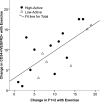Thrombin and exercise similarly influence expression of cell cycle genes in cultured putative endothelial progenitor cells
- PMID: 20378705
- PMCID: PMC2886685
- DOI: 10.1152/japplphysiol.00884.2009
Thrombin and exercise similarly influence expression of cell cycle genes in cultured putative endothelial progenitor cells
Abstract
Acute exercise and exercise training may influence putative endothelial progenitor cell (EPC) number and colony forming units (CFU-ECs), although the mechanisms remain unclear. This study examined the effects of in vitro thrombin supplementation and acute exercise on CFU-EC gene expression, associated with cellular proliferation and differentiation. The effect of habitual physical activity was evaluated through analysis of EPCs from chronically high- and low-active men. Participants were healthy high- and low-active men (n=23), aged 55-80 yr. Circulating CD34+/VEGFR2+ number, CFU-ECs, plasma prothrombin fragment (F1+2), and thrombin-antithrombin III were measured at rest and after 30 min of exercise. Gene expression of cyclin A2, cyclin D1, p27, VE-cadherin, and VEGFR2 was assessed in postexercise CFU-ECs and resting CFU-ECs treated with 0, 1, 5, or 10 U/ml of thrombin. Outcomes were compared between high- and low-active participants. F1+2 and thrombin-antithrombin III, but not CD34+/VEGFR2+ number and CFU-ECs, increased with exercise. Exercise-induced changes in F1+2 correlated with changes in CD34+/VEGFR2+ number in both groups. Thrombin treatments and acute exercise increased cyclin A2 and cyclin D1 expression and decreased p27 expression. One unit per milliliter thrombin increased VEGFR2 and VE-cadherin expression, whereas 5 U/ml, 10 U/ml, and acute exercise did not elicit any changes. An exercise training effect was observed with greater decreases in p27 expression with 5 and 10 U/ml thrombin and greater increases in VEGFR2 and VE-cadherin expression with 1 U/ml thrombin in high-active men. Exercise-induced changes in putative EPC gene expression are associated with thrombin production and may be modulated by long-term exercise training.
Figures





Similar articles
-
Relationship between circulating progenitor cells, vascular function and oxidative stress with long-term training and short-term detraining in older men.Clin Sci (Lond). 2010 Feb;118(4):303-11. doi: 10.1042/CS20090253. Clin Sci (Lond). 2010. PMID: 19723023 Free PMC article.
-
Effects of acute and chronic endurance exercise on intracellular nitric oxide in putative endothelial progenitor cells: role of NAPDH oxidase.Am J Physiol Heart Circ Physiol. 2009 Nov;297(5):H1798-805. doi: 10.1152/ajpheart.00347.2009. Epub 2009 Aug 28. Am J Physiol Heart Circ Physiol. 2009. PMID: 19717732 Free PMC article.
-
Suppressed increase in blood endothelial progenitor cell content as result of single exhaustive exercise bout in male revascularised coronary artery disease patients.Acta Clin Belg. 2012 Jul-Aug;67(4):262-9. doi: 10.2143/ACB.67.4.2062670. Acta Clin Belg. 2012. PMID: 23019801
-
Endothelial progenitor cells and exercise-induced redox regulation.Antioxid Redox Signal. 2011 Aug 15;15(4):997-1011. doi: 10.1089/ars.2010.3734. Epub 2011 Apr 11. Antioxid Redox Signal. 2011. PMID: 21091077 Review.
-
Clonogenic assay of endothelial progenitor cells.Trends Cardiovasc Med. 2013 May;23(4):99-103. doi: 10.1016/j.tcm.2012.09.007. Epub 2013 Feb 1. Trends Cardiovasc Med. 2013. PMID: 23375595 Review.
Cited by
-
Pathologies at the nexus of blood coagulation and inflammation: thrombin in hemostasis, cancer, and beyond.J Mol Med (Berl). 2013 Nov;91(11):1257-71. doi: 10.1007/s00109-013-1074-5. Epub 2013 Aug 17. J Mol Med (Berl). 2013. PMID: 23955016 Free PMC article. Review.
-
Effects of dabigatran in vitro on thrombin biomarkers by Calibrated Automated Thrombography in patients after ischemic stroke.J Thromb Thrombolysis. 2012 Jan;33(1):22-7. doi: 10.1007/s11239-011-0654-x. J Thromb Thrombolysis. 2012. PMID: 22065286
-
Impact of moderate blast exposures on thrombin biomarkers assessed by calibrated automated thrombography in rats.J Neurotrauma. 2013 Nov 15;30(22):1881-7. doi: 10.1089/neu.2012.2758. Epub 2013 Oct 4. J Neurotrauma. 2013. PMID: 23805797 Free PMC article.
-
Circulating Endothelial Progenitor and Mesenchymal Stromal Cells as Biomarkers for Monitoring Disease Status and Responses to Exercise.Rev Cardiovasc Med. 2022 Dec 2;23(12):396. doi: 10.31083/j.rcm2312396. Rev Cardiovasc Med. 2022. PMID: 37680455 Free PMC article.
-
Endothelial progenitor cell mobilization based on exercise volume in patients with cardiovascular disease and healthy individuals: a systematic review and meta-analysis.Eur Heart J Open. 2022 Dec 21;2(6):oeac078. doi: 10.1093/ehjopen/oeac078. eCollection 2022 Nov. Eur Heart J Open. 2022. PMID: 36583078 Free PMC article. Review.
References
-
- American College of Sports Medicine ACSM's Guidelines For Exercise Testing and Prescription. New York: Lippincott Williams & Wilkins, 2000
-
- Asahara T, Murohara T, Sullivan A, Silver M, van der Zee R, Li T, Witzenbichler B, Schatteman G, Isner JM. Isolation of putative progenitor endothelial cells for angiogenesis. Science 275: 964–967, 1997 - PubMed
-
- Bellik L, Ledda F, Parenti A. Morphological and phenotypical characterization of human endothelial progenitor cells in an early stage of differentiation. FEBS Lett 579: 2731–2736, 2005 - PubMed
-
- Blair SN, Kampert JB, Kohl HW, III, Barlow CE, Macera CA, Paffenbarger RS, Jr, Gibbons LW. Influences of cardiorespiratory fitness and other precursors on cardiovascular disease and all-cause mortality in men and women. JAMA 276: 205–210, 1996 - PubMed
-
- Eto M, Rathgeb L, Cosentino F, Kozai T, Luscher TF. Statins blunt thrombin-induced down-regulation of endothelial nitric oxide synthase expression in human endothelial cells. J Cardiovasc Pharmacol 47: 663–667, 2006 - PubMed
Publication types
MeSH terms
Substances
Grants and funding
LinkOut - more resources
Full Text Sources
Medical
Research Materials

